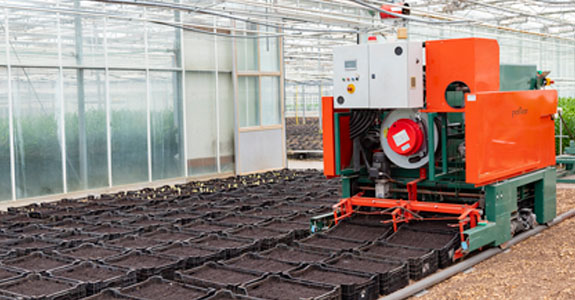Greenhouse technology: Innovations for the present and future
Every day, you rely on technology to keep your greenhouse running smoothly—from ventilation and irrigation systems to boilers and heaters. And, just like your computer or your smartphone, developers continually upgrade operating systems, and the technology required to keep your climate-controlled environment at optimum growing conditions continues to advance.
As a grower, you regularly upgrade your tools to help improve capabilities, optimize yields, and alleviate challenges in the labor market.
“Ten years ago, high tech wasn’t seen a lot in greenhouses,” notes Zach Bruce, Director of Safety Services for Hortica. “But today, automated transplanting systems, advanced environmental controls, and robotics are common—and always evolving.”
The following are some of the primary innovation trends in this industry, focusing on greenhouse automation and smart greenhouse technology.
Automated greenhouses
Today’s greenhouse technology features innovative products designed to maximize crop production and boost profitability. The adage, “work smarter, not harder,” certainly applies here.
From managing the elements of your greenhouse operation to harvesting rainwater, the precision of automation can help enhance crop production and decrease costs.
Some examples of greenhouse automation—sometimes referred to as machine-to-machine (M2M) solutions—using advanced technology include:
Environmental control systems and software applications
Smart technology can help manage your greenhouse operations. For instance, wireless sensors placed throughout your greenhouse measure variables such as temperature, humidity, CO2, and light. These sensors enable grow room controllers to adjust environmental conditions in real time.
Sensors can also send crop-level data—such as leaf length, growth speed, and even pest levels—to an operating system that controls motors to open or close vents or screens based on certain triggers.
In some cases, you can monitor all the variables and adjust conditions through an app on your mobile phone.
Irrigation systems
Self-sufficient rainwater systems aren’t new. But they’re constantly improving. On average, a smart greenhouse can use nearly 98% less water than a greenhouse using traditional irrigation methods.
Many large-scale, high-tech indoor farming operations rely on automated rainwater harvesting systems to irrigate crops. These systems reuse collected rainwater and internal condensation when and where it’s most needed. This also recirculates fertilizer—another way you can potentially save money.
Robotics in high-tech greenhouses
Greenhouses are increasingly adopting robotic processes. Here are a few examples currently used in some advanced commercial greenhouses:
Spacing robots provide more consistent spacing and increase quality by optimizing plant placement and reducing the amount of water, pesticides, herbicides, and fertilizers used.
Pollinator robots perform flower inspection, mapping, pollination, and development tracking.
Harvesting robots accurately identify ripe versus unripe plants, harvest them, and place them in on-board boxing systems.
Pest management robots navigate greenhouses to inspect crops for pests and treat the issue to help improve crop yield, reduce pesticide use, and improve working conditions for employees.
Drone use as part of greenhouse innovations
Drones have been particularly beneficial for greenhouses when inspecting roofs and overhead components.
Per Greenhouse Grower, thanks to advancing technology, more sophisticated sensors, and stronger battery life, drones are now also being used for:
Scouting pests
Monitoring crops
Applying greenhouse shading compounds
Vertical growing
Going from horizontal to vertical growing introduces a range of technical efficiencies. Vertical growing can maximize space and double or triple the inventory within your greenhouse since you’re using nearly every square foot when you garden up-and-down, versus side-to-side. This is a great way to use the power of gravity to enhance irrigation.
A vertical hydroponic system takes advantage of soilless gardening and recirculates water and nutrients. For more details, read our article on the benefits of the vertical growing shift.
Using dynamic lighting for greater yields and lower costs
In their commercial greenhouse market forecast published in 2023, MarketsandMarkets cited solid-state lighting (SSL) technology as one of the key technology trends for this industry. LEDs are the most common form of SSL.
SSL devices provide three distinct advantages:
Spectral control, meaning you can adjust lighting intensity and spectrum levels based on the forecast, plant type, or desired effect
Less radiated heat, meaning light can be placed closer to plants, increasing plant density and lowering water consumption
Increased energy efficiency, saving you money on energy costs
Additionally, you can customize fully programmable light settings for different greenhouse zones.
Advanced analytics and monitoring to optimize yields
As you might expect, with the tools in place to monitor plant growth, health, and production, there are software programs available to store and track the data you collect.
This real-time information helps you increase future yields by knowing the ideal times to care for your plants throughout their lifecycle.
How to insure your greenhouse technology
If you anticipate your business investing in new technologies or updating your greenhouse management operation, ask your insurance provider for guidance, especially when it comes to protecting your investment.
We offer greenhouse growers insurance that includes coverage for plants grown in climate-controlled structures and have the experience and knowledge to assess risks horticultural businesses like yours face, including risks that could impact your greenhouse growing conditions.
If you have questions or would like to learn more about our full range of horticultural business insurance coverages or safety services, contact us. We’re here to help you.
Related links:
As your greenhouse, nursery, or garden center relies more on technology, its online vulnerabilities increase. Learn about common types of cybercrime and how you can help prevent them.
Concerned you may not have proper coverage? Learn more about insurance for greenhouse growers.
We’ll help you develop a workplace injury and accident prevention plan and identify risk exposures. Learn more about our safety and risk management services.
The information in this article is for informational or entertainment purposes only. View our disclaimer by going to terms and conditions and clicking on Learning Center disclaimer in the table of contents.
